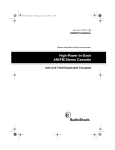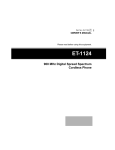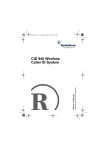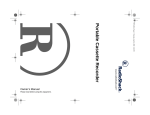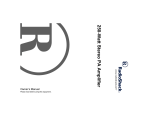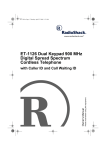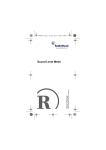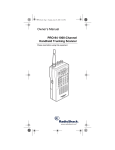Download Radio Shack 4-CHANNEL STEREO SSM-1750 Owner`s manual
Transcript
32-3008.fm Page 1 Thursday, April 6, 2000 4:03 PM Please read before using this equipment. Owner’s Manual SSM-1750 4-Channel Stereo Audio Mixer 32-3008.fm Page 2 Thursday, April 6, 2000 4:03 PM ˆ Contents Features .................................................................................................................................. 4 Preparation ............................................................................................................................. Presetting the Controls ...................................................................................................... Connecting the Outputs .................................................................................................... Connecting Inputs ............................................................................................................. Connecting Microphones ........................................................................................... Connecting Power ............................................................................................................. Connecting a Lamp ........................................................................................................... Connecting Headphones ................................................................................................... Listening Safely ......................................................................................................... 6 6 6 6 7 7 7 7 7 Operation ................................................................................................................................ 7 Presetting the Input Signal Levels ..................................................................................... 8 Presetting the Channel Inputs ................................................................................... 8 Presetting a Microphone ............................................................................................ 9 Presetting the Auxiliary Input ..................................................................................... 9 Mixing the Inputs ............................................................................................................. 10 Playing One Input Source ........................................................................................ 10 Monitoring a Second Input Source ........................................................................... 10 Switching to the Second Input Source ..................................................................... 11 Notes on Mixing ....................................................................................................... 11 Using the Special Controls .............................................................................................. 11 Using the Tone Controls ........................................................................................... 11 Using Gain ............................................................................................................... 11 Setting the Sound Balance ...................................................................................... 12 Using a Microphone ........................................................................................................ 12 Using an XLR Microphone ....................................................................................... 12 Using an AUX Microphone ....................................................................................... 12 Using TALKOVER .................................................................................................... 12 Using MUTE LEVEL ................................................................................................ 12 Using PAN ................................................................................................................ 12 Using SOUND EFFECTS ................................................................................................ 12 Using ECHO EFFECTS .................................................................................................. 12 Adjusting the Echo Delay, Repeat, and Volume ...................................................... 13 Using Sound Effect Devices ............................................................................................ 13 Playing the Signal from the Sound Effect Device .................................................... 13 Playing Input Signals through the Sound Effect Device ........................................... 13 © 2000 Tandy Corporation. All Rights Reserved. RadioShack and RadioShack.com are trademarks used by Tandy Corporation. 2 32-3008.fm Page 3 Thursday, April 6, 2000 4:03 PM Care ....................................................................................................................................... 14 Replacing the Fuse ......................................................................................................... 14 Troubleshooting ................................................................................................................... 14 Specifications ...................................................................................................................... 15 WARNING: To reduce the risk of fire or shock hazard, do not expose this product to rain or moisture. CAUTION RISK OF ELECTRIC SHOCK. DO NOT OPEN. ! CAUTION: TO REDUCE THE RISK OF ELECTRIC SHOCK, DO NOT REMOVE COVER OR BACK. NO USER-SERVICEABLE PARTS INSIDE. REFER SERVICING TO QUALIFIED PERSONNEL. This symbol is intended to alert you to the presence of uninsulated dangerous voltage within the product’s enclosure that might be of sufficient magnitude to constitute a risk of electric shock. Do not open the product’s case. ! This symbol is intended to inform you that important operating and maintenance instructions are included in the literature accompanying this product. 3 32-3008.fm Page 4 Thursday, April 6, 2000 4:03 PM ˆ Features Your RadioShack 4-Channel Stereo Audio Mixer is a sophisticated control center, perfect for mixing sound from multiple playback sources such as a microphone, tuner, CD player, turntable, or the audio output from a VCR. It is ruggedly constructed for home or professional use and its wide-range volume controls let you adjust sound levels to achieve the right mix for playing through your speaker system or for recording. The mixer's many features give you almost limitless sound combinations. 1 DJ MIC — lets you connect a balanced, low impedance microphone with an XLR plug. 2 BASS/MID/HIGH — let you adjust the 5 LEVEL — lets you adjust the microphones' volumes before mixing them in. 6 TALKOVER — decreases the volume of the input sources so you can talk over them using the microphone. tone of the selected input for customized sound. 3 7 MUTE LEVEL— lets you adjust the background music volume when using TALKOVER. 8 CH1, CH2, CH3, CH4 Slide Volume Controls — for fingertip control of sound mixing and fading. GAIN — individual controls let you fine tune each input’s volume. 4 4 PAN — lets you control the output of the DJ MIC and AUX MIC/LINE. Features 32-3008.fm Page 5 Thursday, April 6, 2000 4:03 PM 9 Assign Controls— let you select the input sources to be mixed. 10 CROSS FADER — lets you smoothly switch between two input sources. 11 SOUND EFFECT — let you create a special sound performance using the six preprogrammed sound effects. 12 CUE LEVEL — lets you adjust the headphone's volume. 13 CUE ASSIGN — lets you select the channel where the desired audio input source is located so you can monitor and prepare it before mixing it in. 15 MASTER — adjusts the overall volume of DJ MIG, AUX, CH1, CH2, CH3, CH4, RECEIVE input, and sound effects. 16 MONO/STEREO Selector — lets you set the output to stereo or monaural. 17 POWER — turns the mixer on and off. 18 Lamp Jack — lets you install a 12V/3W lamp to light up the mixer controls. 19 ECHO Controls — let you tailor the sound to compensate for a location’s conditions or for personal preference. 20 VU (Volume Unit) — two meters indicate the total stereo output signal levels. 14 BALANCE — lets you adjust the sound balance between the left and right speakers. 21 Stereo Line Outputs — let you connect the mixer's output to your receiver/amplifier and tape deck so you can play the sounds from your input sources through your speaker system, and record them. 22 Sound Effect Jacks — let you connect another sound effect device, such as an echo reverb, and either play the signal from it or play another input's signal through it. You can also vary the volume of the signal. 23 Stereo Line Inputs — let you connect most line-level audio sources such as a CD player, tape deck, tuner, camcorder, or VCR. 24 Auxiliary Microphone Input — lets you connect a low impedance microphone 1 with a /4-inch plug. 25 Stereo Phono Inputs — for connecting low-level audio sources, such as a turntable with a magnetic cartridge. 26 Mono Line Input — lets you connect a mono input source, such as a wireless microphone receiver. Features 5 32-3008.fm Page 6 Thursday, April 6, 2000 4:03 PM ˆ Preparation PRESETTING THE CONTROLS CONNECTING INPUTS Warning: A sudden high output from the mixer could damage your hearing, especially if you use headphones, and might also damage the audio devices connected to the mixer's output. Before using the mixer, make sure you set your receiver/amplifier's volume control to its minimum volume level setting. Before you connect the power cord, make sure you set POWER to off. To avoid sudden and inaudible sound outputs from any audio devices that you connect to the mixer, be sure to have their power controls set to off, and any tone controls set to flat. You can connect up to ten audio input sources (such as cassette tape decks, CD players, tuners, two magnetic-cartridge turntables, a camcorder or a VCR) to the mixer’s input jacks on the back panel. You can also connect microphones to the appropriate jacks on the top and back panels. 1. Connect the line-level outputs from up to six audio sources to the LINE 1, LINE2, LINE 3, LINE 4, LINE 5, and LINE 6 input jacks, matching left to left, and right to right. Caution: Do not connect an audio source with a line-level output to the low-level PHONO 1, PHONO 2, or AUX MIC audio input jacks. CONNECTING THE OUTPUTS To play the mixer's output signal through your sound system (for events such as parties, dances, conferences, and so on), connect one end of an audio patch cord (not supplied) to the mixer's OUTPUT AMP L (white) and R (red) jacks, then connect the other end to your receiver/amplifier's left and right input jacks, matching left to left, and right to right. To record the mixer's output signal, connect one end of an audio patch cord (not supplied) to the mixer's OUTPUT REC L (white) and R (red) jacks, then connect the other end to your tape deck's left and right line input jacks, matching left to left, and right to right. 6 2. Connect the low-level outputs from up to two audio sources (such as magnetic cartridge turntables) to the PHONO 1 and PHONO 2 input jacks, matching left to left, and right to right. Note: If you connect magnetic cartridge turntables, connect their ground wires (usually black or green) to GND. 3. Connect a sound effect device (such as an echo reverb or a digital sampler processor) to the EFFECT SEND (output) and EFFECT RECEIVE (input) jacks, matching left to left, and right to right. 4. Connect a mono input source (such as a wireless microphone receiver) to the AUX LINE MONO jacks, matching left to left, and right to right. Preparation 32-3008.fm Page 7 Thursday, April 6, 2000 4:03 PM Connecting Microphones You can connect two microphones (not supplied) to the mixer. Connect a microphone with an XLR plug to DJ MIC on the top panel’s upper left corner. Connect a microphone with a 1/4-inch (6.35 mm) plug to AUX MIC on the back panel’s lower right corner. CONNECTING HEADPHONES To listen in privacy or monitor the audio source inputs so you can locate an exact passage or section before mixing it, connect a pair of stereo headphones (not supplied) with a 1/4-inch (6.35 mm) plug to the PHONES jack on the mixer's lower right corner. Your local Radio Shack store carries a wide selection of headphones. CONNECTING POWER Note: Before you connect the mixer's power cord, make sure power is turned off by pressing POWER (if the control is out, the power is off). Connect the power cord to a standard AC outlet. Caution: The power cord has a polarized plug that fits only one way into a standard AC outlet. If the plug does not fit, turn it over so it fits properly. Do not force it! Listening Safely Do not listen at extremely high volume levels. Extended, high-volume listening can lead to permanent hearing loss. To protect your hearing when you use headphones, always follow these guidelines to set the listening volume. • Set CUE LEVEL to 0 before you begin listening. • After you put on the headphones, adjust CUE LEVEL to a comfortable listening volume level. CONNECTING A LAMP The mixer has a 12V/3W MAX LAMP socket for connecting a 12V/3W BNC lamp so you can see the control panel in dark or low light conditions. • Once you set the headphones' volume, do not increase it. Over time, your ears adapt to the volume level, so a volume level that does not cause discomfort might still damage your hearing. ˆ Operation 1. Set the volume levels on the output devices (receiver, amplifier, or tape deck) to minimum and turn them on. 4. Preset the input signal levels (see “Presetting the Input Signal Levels” on Page 8). 2. Press POWER to turn on the mixer. The POWER indicator lights. 5. Mix the audio input sources (see “Mixing the Inputs” on Page 10). 3. Turn on the input sources you want to mix. Operation 7 32-3008.fm Page 8 Thursday, April 6, 2000 4:03 PM 6. After you finish mixing, turn down the volume on the output audio devices, turn off the input and output audio devices (amplifiers, tape decks, and so on), then press POWER so it pops up to turn off the mixer. The POWER indicator turns off. Notes: • If you did not connect an input source to every jack or do not want to mix every input source connected to the mixer's input jacks, you do not need to preset every channel input. Decide which source(s) you want to preset and mix, then preset those inputs only. PRESETTING THE INPUT SIGNAL LEVELS • While you adjust the input signal levels for channels 1, 2, 3, and 4, either use the headphones or turn up the receiver/ amplifier's volume to a comfortable listening level (not necessarily the final usable level). To avoid accidentally over-driving a channel or prematurely mixing in an audio input source, start with the following settings: • All volume slide controls set to 0. • Do not play a quiet portion of music while you adjust the volume levels, otherwise the volume levels for channels 1, 2, 3, and 4 will be over-driven during the loud portions of the music. • Both ASSIGN switches set to OFF. • All GAIN knobs set mid level. • All HIGH, MID, and BASS controls, CUE LEVEL, DJ MIC LEVEL, AUX LEVEL, SEND, RECEIVE, and MASTER set to 0. Rotate MASTER clockwise and temporarily set it to about the 5th marker. Note: The MASTER volume control adjusts the overall volume of DJ MIC, AUX, CH1, CH2, CH3, CH4, RECEIVE input, and sound effects. The mixer uses two volume unit (VU) meters to indicate the total stereo output signal level. For the best results, each input signal level should normally be set so the VU meters never move into the red range (0 or above). Distortion is likely to occur on audio peaks if the meter moves into the red range. For monaural output, set MONO/STEREO to MONO. For stereo output, set it to STEREO. Presetting the Channel Inputs Follow these steps to preset each channel input you plan to mix. 8 1. Set the channel selector to the desired input source. 2. Start playback of the selected input source. 3. Adjust the HIGH, MID, and BASS controls as desired. See “Using the Tone Controls” on Page 11. Note: If you are using an external equalizer, leave the tone controls set to 0 and adjust the tone on the external equalizer. 4. Slowly slide up the channel volume control until you get a reading of up to 0 on both VU meters. Important: Note the channel volume level slide control's setting for the selected audio source, so each time you want to mix that source you can slide the volume control to the correct setting. Operation 32-3008.fm Page 9 Thursday, April 6, 2000 4:03 PM Notes: Notes: • If it was necessary to set the channel volume level slide control to 10 to get a reading of up to 0 on the VU meter, then slide it down to about 8 and adjust the GAIN control to get a reading of up to 0 on the VU meters. (See “Using Gain” on Page 11.) • If it was necessary to set DJ MIC LEVEL or AUX LEVEL all the way to 10 in order to get a reading of up to 0 on the VU meter, then turn it down to about 8 and adjust the DJ MIC GAIN control to get a reading of up to 0 on the VU meters. (See “Using Gain” on Page 11.) • If the above does not work, set GAIN to mid level and rotate MASTER clockwise until you get a reading of 0 on the VU meters. If that does not work, set DJ MIC GAIN or AUX GAIN to mid level and rotate MASTER clockwise until you get a reading of 0 on the VU meters. • Readjusting MASTER affects the level of the previously set input sources. You must readjust those sources until you get a reading of up to 0 on the VU meters for each input source. • If you must readjust MASTER, remember, doing so affects the level of the previously set input sources. You must readjust those sources until you get a reading of up to 0 on the VU meters for each input source. 5. Stop playback of the selected input source. 3. If your XLR or auxiliary microphone has an ON/OFF control, set it to OFF. 6. Repeat these steps for each channel input you plan to mix. If your XLR or auxiliary microphone does not have an ON/OFF control, set DJ MIC LEVEL or AUX LEVEL to 0. Presetting a Microphone 1. If your XLR or auxiliary microphone has an ON/OFF control, set it to ON. If your XLR or auxiliary microphone does not have an ON/OFF control, set DJ MIC LEVEL or AUX LEVEL to 0. 2. While talking continuously, adjust DJ MIC LEVEL or AUX LEVEL until you get a reading of up to 0 on both VU meters. (See “Using an XLR Microphone” on Page 12 and “Using an AUX Microphone” on Page 12.) Important: Note the DJ MIC LEVEL or AUX LEVEL setting, so each time you want to mix the microphone, you can set the control to the correct setting. Presetting the Auxiliary Input 1. To preset the AUX LINE input source, set AUX to LINE. 2. Start playback of the selected input source. 3. Adjust the HIGH, MID, and BASS controls as desired. See “Using the Tone Controls” on Page 11. Note: If you are using an external equalizer, leave the tone controls set to 0 and adjust the tone on the external equalizer. 4. Slowly adjust AUX LEVEL until you get a reading of 0 on both VU meters. Operation 9 32-3008.fm Page 10 Thursday, April 6, 2000 4:03 PM Important: Note the AUX LEVEL setting, so each time you want to mix that source you can set the control to the correct setting. Notes: To avoid sudden and inaudible sound outputs from any audio devices that you connect to the mixer, be sure to set their power controls to off and any tone controls to flat. Playing One Input Source • If it was necessary to set the AUX LEVEL control to 10 to get a reading of up to 0 on the VU meter, then set AUX LEVEL to about 8 and adjust the AUX GAIN control to get a reading of up to 0 on the VU meters. (See “Using Gain” on Page 11.) • If the above does not work, set AUX GAIN mid level and rotate MASTER clockwise until you get a reading of 0 on the VU meters. • Readjust MASTER affects the level of the previously set input sources. You must readjust those sources until you get a reading of up to 0 on the VU meters for each. 5. Stop playback of the selected input source. 1. Set ASSIGN A to the desired source, then set CROSS FADER to A. 2. Select the mixer's input — CH 1, CH 2, CH 3, or CH 4. 3. Set the input selector control to the input source you want to play first through your sound system. 4. Adjust the receiver's or amplifier's (not the mixer's) volume control to the desired volume. Make sure the first input source's volume level slide control is set to the correct preset position. 5. Start playback of the input source. Monitoring a Second Input Source MIXING THE INPUTS You can connect input signals from up to 12 audio sources, select any two of the channel input sources, then mix them so only one or both play through your sound system. Mixing requires three operations: Monitoring a second input source's signal level requires selecting the input source that is not currently playing, finding the desired section you want to mix, then adjusting the source's sound level so it matches the volume level of the source currently playing. 1. Connect and put on headphones. • Playing one input source. Note: You can listen to one channel through the headphones while the other channel is playing through the sound system. • Monitoring the next input source. • Switching to the next input source. You can start with either of the two selected sources. To prevent prematurely mixing audio sources, set all volume level controls to 0. 10 2. Set ASSIGN B to the second input source. 3. Set CUE ASSIGN to the audio input source (CH 1, CH 2, CH 3, or CH 4) you want to monitor. Operation 32-3008.fm Page 11 Thursday, April 6, 2000 4:03 PM 4. Set the desired channel volume level slide control to the preset position. • To mix any two inputs selected by the ASSIGN switches, set each ASSIGN switch to the desired channel. Then use CROSS FADER to mix the two. 5. Adjust CUE LEVEL to a comfortable listening level. • Do not slide CROSS FADER to the center if you want to monitor one channel while the other is playing. Otherwise, the sound from the channel you monitor will also be heard through your sound system. Instead, slide CROSS FADER to the channel you are not monitoring. For example, to monitor channel 1 (selected by ASSIGN A) while channel 2 (selected by ASSIGN B) is playing, slide CROSS FADER to B. 6. Start playback of the input source you want to play next through your sound system. 7. Set the input device to the desired section of music, then stop or pause the input device. Switching to the Second Input Source • Use CUE LEVEL to listen to the input controlled by the CUE ASSIGN switch and what is playing on the currently selected output device. 1. Start playback of the second input source. 2. Slide CROSS FADER from A to B when you are ready to play the second source’s sound through your sound system. USING THE SPECIAL CONTROLS Slide CROSS FADER: • To the left to fade in the channel selected by ASSIGN A and fade out the channel selected by ASSIGN B. • To the right to fade in the channel selected by ASSIGN B and fade out the channel selected by ASSIGN A. • To the center to equally mix the two. Notes on Mixing • If you set CROSS FADER to A to play the channel selected by ASSIGN A, then you must set CUE ASSIGN to CH 1 to monitor CH 1, to CH 2 to monitor CH 2, to CH 3 to monitor CH 3, and to CH 4 to monitor CH 4. The same applies when you set CROSS FADER to B. Using the Tone Controls Your mixer has a set of tone controls for each microphone and for channels 1–4. You can tailor the high, middle, and low frequency sounds for each. For normal sound, leave BASS, MID, and HIGH set to 0. Rotate HIGH, MID or BASS toward +10 to increase, or toward –10 respectively to decrease the high, middle, and low frequency sounds. Using Gain Since the input levels of each sound source are different, the GAIN controls let you fine tune each selected input's volume. Rotate the desired GAIN control toward MAX to increase the volume and toward MIN to reduce it. Operation 11 32-3008.fm Page 12 Thursday, April 6, 2000 4:03 PM Note: We recommend you not adjust the GAIN controls after you have preset the inputs as some sound imbalance could occur. Setting the Sound Balance BALANCE lets you adjust the sound balance between the left and right speakers. If your speakers are properly positioned and your listening area is centered between the speakers, the center setting of the control is usually the best. Using TALKOVER To use the microphone and reduce other audio inputs so the microphone can be heard more clearly, set TALKOVER to ON. To turn off TALKOVER, set TALKOVER to OFF. All the audio inputs including DJ MIC and AUX MIC play at the same output level, and the background music volume is not reduced. Using MUTE LEVEL If the sound seems to be louder from one speaker, adjust BALANCE until the sound seems to be coming from a point midway between the speakers. USING A MICROPHONE Using PAN Using an XLR Microphone To mix the microphone connected to the XLR jack with other audio input sources, adjust DJ MIC LEVEL to increase or decrease the microphone volume without affecting the volume of the other inputs. Set DJ MIC LEVEL to 0 when you are not using the DJ microphone. Or, if the microphone has an ON/OFF control, set it to OFF and leave DJ MIC LEVEL at its preset position. Using an AUX Microphone To mix a microphone connected to the AUX MIC jack with other audio input sources, set AUX MIC/LINE to MIC. Adjust AUX LEVEL to increase or decrease the microphone volume without affecting the volume of the other inputs. When you are not using an AUX microphone, set AUX MIC/LINE to LINE. This lets you mix the output from the device connected to AUX LINE MONO jacks. 12 To increase background music when using TALKOVER, rotate MUTE LEVEL toward MIN. To reduce background music, rotate it toward MAX. To play either microphone or the AUX LINE output on the left or right channel, adjust the appropriate PAN control. Set it to L to play through the left channel, to R to play through the right channel, or to any other position between L and R to play through both channels. USING SOUND EFFECTS There are six preprogrammed sound effects for your mixing selection — a hi-hat close, a rim shot, a cow bell, a cymbal, a bass drum, and a laser drum. To play a sound effect, repeatedly press or hold down the desired SOUND EFFECT button. Rotate SOUND EFFECT LEVEL left or right to increase and decrease the sound effect volume. USING ECHO EFFECTS The mixer plays echo effects, and lets you adjust the echo delay, the number of echo repeats, and the echo's volume. Operation 32-3008.fm Page 13 Thursday, April 6, 2000 4:03 PM The echo is applied to the sound before all the inputs are mixed. Playing Input Signals through the Sound Effect Device Set ECHO to MIC to turn on the echo effect for the microphones and the AUX LINE input. You can play inputs selected by the channel selectors, DJ MIC, or AUX through other sound effect devices connected to the mixer, such as an echo reverb or a digital sampler processor, and control playback through the mixer. To play selected inputs through the sound effect device, set SEND ASSIGN to the selected input. Set ECHO to MUSIC to turn on the echo effect for Channels 1, 2, 3, and 4 outputs. To turn off the echo effect, set ECHO to OFF. Adjusting the Echo Delay, Repeat, and Volume The ECHO DELAY control lets you adjust the time delay for an echo. Set ECHO DELAY to 0 for a minimum time delay and to 10 for a maximum time delay. The SEND control lets you adjust the volume of the selected sound to the sound effect device without changing the device's volume. Rotate SEND toward 10 to increase the volume and toward 0 to decrease it. The ECHO REPEAT control lets you control the length of time a tone is repeated (reverberation). Set ECHO REPEAT to 10 for the longest time repeat and to 0 for the shortest. The ECHO LEVEL control lets you adjust the output level of the echo effect. Rotate ECHO LEVEL toward 10 to increase the echo level and toward 0 to decrease it. USING SOUND EFFECT DEVICES Playing the Signal from the Sound Effect Device To play signals from a device connected to the EFFECT jacks, set the RECEIVE switch to ON. When you are not using the connected inputs, set the RECEIVE switch to OFF. Rotate RECEIVE to adjust the volume of the input connected to the EFFECT jacks without changing the sound effect device's volume. Rotate RECEIVE toward 10 to increase the volume and toward 0 to decrease it. Operation 13 32-3008.fm Page 14 Thursday, April 6, 2000 4:03 PM ˆ Care REPLACING THE FUSE To enjoy your mixer for a long time: • Keep the mixer dry. If it gets wet, wipe it dry immediately. Your mixer requires a 250-volt, 0.5-amp fuse to protect it from power surges and short circuits. If the mixer suddenly turns off or will not turn on, the fuse could be blown. Replace the fuse with a 0.5-amp, 250volt, fast-acting, 11/4 x 1/4 inch fuse (not supplied). • Use and store the mixer only in normal temperature environments. • Handle the mixer gently and carefully. Do not drop it. Follow these steps to replace the fuse. • Keep the mixer away from dust and dirt. • Wipe the mixer with a damp cloth occasionally to keep it looking new. 1. Using a Phillips screwdriver, unscrew the fuse compartment cap on the back of the mixer. Modifying or tampering with the mixer’s internal components can cause a malfunction and might invalidate its warranty. If your mixer is not performing as it should, take it to your local RadioShack store for assistance. 2. Remove the old fuse and replace it with an identical fuse. Caution: Never use a fuse of a different type or rating. 3. Replace the fuse compartment cap. ˆ Troubleshooting We do not expect you to have any problems with your mixer, but if you have a problem, this information might help. If the problem persists, take the mixer to your local RadioShack store for assistance. Problem The mixer does not work. Possible Solution Check the AC power connection and make sure the AC outlet is “live.” Check the power connection to the rest of the system (amplifier/ receiver, input sources, and so on). Check the fuse. See “Replacing the Fuse” on Page 14. No signal from an audio input sources. Make sure the TALKOVER switch is set to OFF. Check the mixer’s and the source’s control settings. Check the connection between the mixer and the input source. You are getting a hum from the PHONO sources. 14 Make sure the turntable’s ground wire (usually black or green) is connected to the GND screw on the back of the mixer. Care 32-3008.fm Page 15 Thursday, April 6, 2000 4:03 PM Problem Possible Solution You are getting a hum from other input source Make sure there are no low-level inputs connected to the LINE input jacks. You are getting feedback noise. Move the microphone further away from the output speakers or use a unidirectional microphone. ˆ Specifications Input Sensitivity/Impedance DJ MIC (XLR jack) ............................................................. 1.5 mV, 600 ohms, Balanced/Unbalanced AUX MIC (Phone jack) ....................................................................... 1.5 mV, 600 ohms, Unbalanced Phono ......................................................................................................................... 3 mV/50 kOhms Line ........................................................................................................................ 150 mV/27 kOhms Output Level Main Out ......................................................................................................................... 2V/10 kOhms Record .................................................................................................................... 150 mV/10 kOhms Send ....................................................................................................................... 150 mV/10 kOhms Frequency Response ................................................................................................ 20–20k Hz ±3 dB S/N Ratio Mic ............................................................................................................................................... 55 dB Phono .......................................................................................................................................... 65 dB Line ............................................................................................................................................. 75 dB Distortion Mic .............................................................................................................................................. 0.20% Phono ......................................................................................................................................... 0.08% Line ............................................................................................................................................ 0.05% Tone Control, DJ MIC, AUX, CH 1, CH 2, CH 3, CH4 HIGH Boost/Cut Range .............................................................................................. ±10dB at Center MID Boost/Cut Range ................................................................................................ ±10dB at Center BASS Boost/Cut Range ............................................................................................. ±10dB at Center ECHO Delay Time .............................................................................................................. 50 –120ms TALKOVER Attenuation ................................................................................................... –8 to –38 dB Power Source ......................................................................................................... AC 120V, 60Hz, 20 Watt Power Fuse ..................................................................................................................... 0.5 Amp/250 Volts 7 Dimensions (HWD).................................................................................................... 4 /16 × 19 × 11 Inches (113 × 482 × 280 mm) Weight ......................................................................................................................................... 11 Ibs 6 oz (5.15 kg) Specifications are typical; individual units might vary. Specifications are subject to change and improvement without notice. Specifications 15 32-3008.fm Page 16 Thursday, April 6, 2000 4:03 PM Limited One-Year Warranty This product is warranted by RadioShack against manufacturing defects in material and workmanship under normal use for one (1) year from the date of purchase from RadioShack company-owned stores and authorized RadioShack franchisees and dealers. EXCEPT AS PROVIDED HEREIN, RadioShack MAKES NO EXPRESS WARRANTIES AND ANY IMPLIED WARRANTIES, INCLUDING THOSE OF MERCHANTABILITY AND FITNESS FOR A PARTICULAR PURPOSE, ARE LIMITED IN DURATION TO THE DURATION OF THE WRITTEN LIMITED WARRANTIES CONTAINED HEREIN. EXCEPT AS PROVIDED HEREIN, RadioShack SHALL HAVE NO LIABILITY OR RESPONSIBILITY TO CUSTOMER OR ANY OTHER PERSON OR ENTITY WITH RESPECT TO ANY LIABILITY, LOSS OR DAMAGE CAUSED DIRECTLY OR INDIRECTLY BY USE OR PERFORMANCE OF THE PRODUCT OR ARISING OUT OF ANY BREACH OF THIS WARRANTY, INCLUDING, BUT NOT LIMITED TO, ANY DAMAGES RESULTING FROM INCONVENIENCE, LOSS OF TIME, DATA, PROPERTY, REVENUE, OR PROFIT OR ANY INDIRECT, SPECIAL, INCIDENTAL, OR CONSEQUENTIAL DAMAGES, EVEN IF RadioShack HAS BEEN ADVISED OF THE POSSIBILITY OF SUCH DAMAGES. Some states do not allow limitations on how long an implied warranty lasts or the exclusion or limitation of incidental or consequential damages, so the above limitations or exclusions may not apply to you. In the event of a product defect during the warranty period, take the product and the RadioShack sales receipt as proof of purchase date to any RadioShack store. RadioShack will, at its option, unless otherwise provided by law: (a) correct the defect by product repair without charge for parts and labor; (b) replace the product with one of the same or similar design; or (c) refund the purchase price. All replaced parts and products, and products on which a refund is made, become the property of RadioShack. New or reconditioned parts and products may be used in the performance of warranty service. Repaired or replaced parts and products are warranted for the remainder of the original warranty period. You will be charged for repair or replacement of the product made after the expiration of the warranty period. This warranty does not cover: (a) damage or failure caused by or attributable to acts of God, abuse, accident, misuse, improper or abnormal usage, failure to follow instructions, improper installation or maintenance, alteration, lightning or other incidence of excess voltage or current; (b) any repairs other than those provided by a RadioShack Authorized Service Facility; (c) consumables such as fuses or batteries; (d) cosmetic damage; (e) transportation, shipping or insurance costs; or (f) costs of product removal, installation, set-up service adjustment or reinstallation. This warranty gives you specific legal rights, and you may also have other rights which vary from state to state. RadioShack Customer Relations, 200 Taylor Street, 6th Floor, Fort Worth, TX 76102 We Service What We Sell RadioShack A Division of Tandy Corporation Fort Worth, Texas 76102 12/99 32-3008 04A00 Printed in China
















